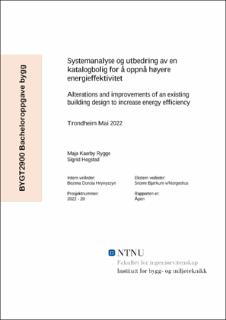| dc.contributor.advisor | Hrynyszyn, Bozena Dorota | |
| dc.contributor.advisor | Bjørkum, Snorre | |
| dc.contributor.author | Rygge, Maja Kaarby | |
| dc.contributor.author | Hogstad, Sigrid | |
| dc.date.accessioned | 2022-06-29T17:19:20Z | |
| dc.date.available | 2022-06-29T17:19:20Z | |
| dc.date.issued | 2022 | |
| dc.identifier | no.ntnu:inspera:106805903:106810207 | |
| dc.identifier.uri | https://hdl.handle.net/11250/3001595 | |
| dc.description.abstract | Denne bacheloroppgavens formål er å undersøke forskjellige utbedringer for å oppnå definerte nivåer av energieffektivitet. Disse utbedringene vil legge grunnlaget for å sammenligne nivåenes hensiktsmessighet i sammenheng med kostnad og klimagass. I oppgaven vil det bli tatt utgangspunkt i en katalogbolig fra Norgeshus, med navn Dråpen Moderne. Byggets estetikk og generelle fysikk skal beholdes, og bli tilnærmet den opprinnelige modellen.
Forskjellige programvarer vil bli benyttet for å studere en rekke tiltak og scenarier, og disse resultatene vil bli presentert og kommentert i løpet av oppgaven. Disse scenariene vil danne grunnlaget for konklusjonen, som vil ende i tre omprosjekteringsforslag; med hvert sitt nivå av energieffektivitet. For å oppnå dette vil forskjellige bygningskomponenter bli vurdert, sammen med en betraktning av tekniske anlegg og deres energiproduksjon.
Det er optimalt å beholde dimensjoner og designet for den opprinnelige modellen, og det vil dermed ikke gjøres endringer på dette med mindre det er absolutt nødvendig. Dette vil føre til at omprosjekteringsforslagene i teorien skal bli enkle å implementere, enten ved å innføre spesifikke tiltak eller forslaget i sin helhet. Med denne tilnærmingen vil hvert scenario effektivitet avdekkes, og resultatene for hvert scenario vil presenteres i oppgaven. Dette er gjort med et mål om å synliggjøre fordelene tilknyttet disse utbedringene og hva de betyr for energieffektiviteten, som gir mulighet for å håndplukke de beste tiltakene.
De ulike analysene resulterte i et klart foretrukket nivå av energieffektivitet; Nullenergibygget. Omprosjekteringen til nullenergibygg hadde ikke bare lavt klimagassavtrykk, men også en kort nedbetalingstid for den økonomiske investeringen. Den vil også ha en årlig besparelse på hele 18 268 kr sammenlignet med den opprinnelige modellen. Dette er som følge av kombinasjonen av et redusert oppvarmingsbehov samt implementeringen av tekniske anlegg.
Passivhuset og plusshuset viste andre kvaliteter. Passivhuset halverte oppvarmingsbehovet til den opprinnelige modellen, og ble brukt som en base for de to andre omprosjekteringsforslagene. Dette var også den billigste investeringen rent økonomisk, med den korteste nedbetalingstiden. Plusshuset på sin side var den dyreste av alle forslagene, men kompenserer for klimagassutslippene gjennom hele sitt livsløp, med mer. I tillegg til å kompensere for seg selv så sparer plusshuset miljøet for 50 267 CO2-ekvivalenter. Plusshuset sin produksjon av overskuddsenergi medfølger også salg av strøm, som vil kunne gi en årlig inntjening og besparelse på 20 488 kr. | |
| dc.description.abstract | This thesis is aiming to find different ways of accomplishing energy efficiency to reach the various classifications. The results will be used to assess the different classifications to find which solution will be the most applicable regarding productivity and cost. To execute this project the model house Dråpen Moderne will be used as a base. This model is produced by Norgeshus, and it is desirable that the design will mainly remain the same as the original model.
With the use of various software to examine different measures and scenarios, the results are presented and compared during this thesis. To achieve the different classifications some scenarios will be analyzed. These scenarios will create the framework conditions for the thesis, together with measures that will be considered. This leads to three different proposals suggested, which each one will fulfill different classifications of energy efficiency. To achieve this, several values of different building components will be considered, together with the use of technical installations and their energy production.
It is optimal if the design and general dimensions for the model is kept intact, hence it will be avoided to make changes to this unless completely necessary. This will contribute to making it easier to implement the different project proposal presented in this thesis, either as a complete design or apply some specific components of the proposal. With this approach each scenario will show the benefits isolated for that calculation only. This is aimed to showcase the benefits of different measures for making the building more energy efficient and gives the opportunity to apply the most efficient changes.
The different analyses results in a definite preferred level of energy efficiency; The Zero Energy Building proposal. The Zero Energy building had not only a low impact on climate, but also a short payback period for the economical investment made. It will also after the payback period have a yearly profit of 18 268 NOK compared to the original model. This is due to the combination of implemented energy production and the reduction of energy demand, compared to the original model.
For the Passive house and Plus house proposals both showed other qualities. The passive house was used as a base for the other two proposals and gave a big reduction in the energy demand. This was initially the cheapest investment to begin with, in addition to having the shortest payback period. The plus house on the other hand is more expensive but compensates for all the greenhouse gasses it releases during its lifetime, plus more. In addition, it atones for 50 267 CO2-equivalents. That corresponds to 26 roundtrip flights from Oslo to New York. | |
| dc.language | nob | |
| dc.publisher | NTNU | |
| dc.title | Systemanalyse og utbedring av en katalogbolig for å oppnå høyere energieffektivitet | |
| dc.type | Bachelor thesis | |
